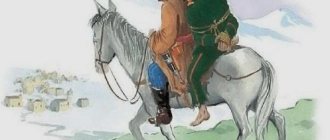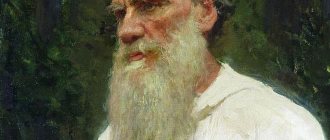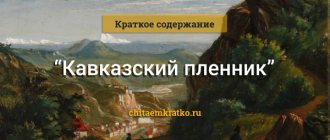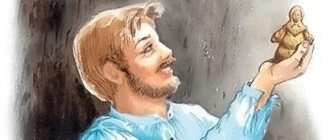- Essays
- On literature
- Tolstoy Lev
- Based on the story Prisoner of the Caucasus
Lev Nikolayevich Tolstoy’s story “Prisoner of the Caucasus” is based on real events that happened to him personally during the Caucasian War under Nicholas I.
The main character of the work is the Russian officer Zhilin, who served in the Caucasus. By origin, he was an impoverished nobleman, however, despite this, he was honest, had a kind soul and pure intentions. He was short in stature, but quite strong. The hero’s elderly mother asks to visit her and he goes to her along with the convoy, taking leave. And on the way he is captured by the Tatars, who captured him for ransom. This happens through the fault of his comrade, officer Kostylin, who, showing unimaginable cowardice, leaves Zhilin, taking his gun with him.
While in captivity, Zhilin was sold to Abdul, with whose daughter, the charming girl Dina, he became friends over time, fashioning clay dolls for her. The girl, in return, helped him to the best of her ability, bringing him food such as cakes, meat and milk. Zhilin manages to establish relationships with the Tatars: he is constantly engaged in work, looking closely at people, and as a result, he is locked in the barn only at night, since he manages to win the trust of the Tatars.
Kostylin, an overweight peasant from a wealthy landowner family, distinguished by his cowardice, was also captured and ended up with the same owner as Zhilin.
Tolstoy very eloquently points out to us the contrast between these two heroes. Strong-willed, courageous, resourceful Zhilin and passive, selfish and deprived of intelligence Kostylin. And despite these obvious differences, throughout the entire story Zhilin really tried to help his comrade. Having dug under the barn, the heroes intend to escape, but due to Kostylin’s fault they fail.
Not caring about her own fate, the owner’s daughter Dina once again comes to Zhilin’s aid. Zhilin travels many miles with shackles on his feet before meeting soldiers and Cossacks.
However, the main idea of this work is not only to show the example of Zhilin as a positive hero and to focus on the fact that we should all take an example from him, but also how stupid and inhumane the Caucasian War was, because Both sides of the warring nations have both bad and good people.
Option 2
The story “Prisoner of the Caucasus” by Lev Nikolaevich Tolstoy is based on real historical events. These events took place during the war of 1817-1864, when the Russians waged armed clashes with the highlanders due to the inclusion of the regions of Dagestan and Chechnya, the Kuban region and the Black Sea coast of the North Caucasus into the Russian Empire. The material for this work was the circumstances from the author’s life in the Caucasus, as well as the memories of officers and soldiers who fought in that war.
The main characters of the story are two officers who served in the Caucasus, Zhilin and Kostylin. Zhilin was from an impoverished noble family, and Kostylin was from a wealthy one. The first hero did not have enormous physiological abilities, yes, he was strong, but not very tall, and was distinguished by his intelligence. The second hero is a ponderous man, overweight and weak-hearted.
The author in the story depicts the relationships between people of different faiths, ages and genders. The story “Prisoner of the Caucasus” reveals the shortcomings of people, such as fear, greed, betrayal, pride, heartlessness, and vindictiveness. But it is camaraderie, faith, courage, courage, cordiality, perseverance and resourcefulness that win and bring the story to a happy ending.
The hero of the story, Zhilin, showed himself on the positive side. While in captivity, he tried to observe people, make acquaintances with them, and always tried to keep himself busy with something. Eventually, this led him to meet Dina, a Tatar girl. Their morals are very similar. These characters are kind-hearted, considerate, brave and sincere. They found a common language, a man and a little girl. Dina, in return for Zhilin’s simple toys, brought him food, which helped him survive in captivity.
The opposite of Zhilin is Kostylin, the negative character of the story. In his character, the reader sees fear and timidity, and betrayal when meeting an enemy. When meeting the Tatars, Kostylin, unlike Zhilin, without thinking about his friend, threw down his gun and let go of his horse. In captivity he was passive, withdrawn, not even thinking about escape. Considering himself superior to the Tatars, he did not talk to them, not even to the inhabitants of the village. His time was spent only waiting for the ransom. And during the first escape, selfishness and indifference towards his comrade appeared.
The first escape did not work out, and the life of the two friends got much worse. But Zhilin continued to think about escaping, and in Kostylin, during the entire story, the only noble act awoke - to refuse to escape, no matter what would create unnecessary obstacles for Zhilin.
At the end of the story, Zhilin still manages to escape from captivity, but his friend was brought in barely alive about a month later. The main reflection of the story is the futility of war. The result, as always, is not happy - it is countless losses and casualties. The moment when friendship remains forever.
Essay “Prisoner of the Caucasus”, 5th grade
The famous Russian writer - Lev Nikolaevich Tolstoy - wrote the work “Prisoner of the Caucasus” based on real events that took place in the Caucasus during the war between Russians and highlanders. The author also mentions fragments from his life in the Caucasus, various memories of soldiers who fought wars there.
The main characters in the story are officers Zhilin and Kostylin. They are absolutely opposite to each other, have different characters. The work shows relationships between people of different genders, ages and nations. Here we fully observe how various human qualities are revealed: timidity, greed, arrogance, selfishness, vindictiveness. However, in the end, as usual, good wins, and with it courage, perseverance and resourcefulness.
Throughout the story, Zhilin tried to find ways out of difficult situations. Even when he was in captivity, he was able to meet the Tatar girl Dina. She was the one who helped save his life. When the first escape from captivity failed, Zhilin did not give up and tried to break free again. But Kostylin, on the contrary, showed himself when meeting with enemies as a coward and a traitor. Because of him, when Zhilin and Kostylin escaped from captivity, they were found and returned there, because he suffered and moaned all the way. However, at the end of the work, something awakened in Kostylin, and he decided to abandon the joint escape. As a result, Zhilin ran alone, and the girl Dina helped him with this.
Based on all of the above, we can come to the conclusion that war is nonsense. The result is always the same: grief for people and millions of innocent victims. But friendship is forever.
Essay 3
In the story “Prisoner of the Caucasus,” written primarily for children, L.N. Tolstoy raises many important, difficult topics even for adults: duty, human relationships, war, selflessness.
The story is similar to a parable or a fairy tale - the characters are extremely simple, archetypal, the narrative is dynamic and simple, the main character - Zhilin - contains in his image all the traits inherent in a conventional “good” person: he is brave, honest, smart, fair, kind, selfless , proactive. His complete antipode is Kostylin - a lethargic, cowardly, weak person both in body and character. The author contrasts them, who find themselves in the same situation, with each other. So, for example, they are captured for different reasons: Zhilin because Kostylin got scared and abandoned him, and Kostylin because of his own sluggishness. In response to the captors’ demand to write home asking for a ransom, Kostylin immediately agrees to ask for five thousand, while Zhilin, not agreeing to even three, drops the price to five hundred. And even after this, he writes the wrong address - he does not want to ruin his mother. Living in the village as prisoners, the heroes behave differently: while Kostylin sleeps all day long and waits to be ransomed, Zhilin makes toys for the girls and children, repairs watches and other things for the inhabitants of the village, thereby winning them over. The first escape attempt fails precisely because of Kostylin - he cannot walk, and Zhilin, confident that he cannot abandon his comrade, carries him on his back, which is why he is caught by his pursuers. Kostylin does not agree to the second attempt to escape (possible only thanks to Dina, whom, as written above, Zhilin, like many residents of the village, won over), saying that he would not pull it off. This long, multifaceted comparison, stretched throughout the story, of course, serves only one purpose - to show “what is good and what is bad.”
And if this topic is addressed directly and obviously, then another, no less important topic is treated more elegantly. This is the theme of war, the relationship between warring parties: not states and armies, but ordinary people. In the scene of the capture of Zilina, people called Tatars (obviously they are Chechens) are perceived by him as ugly, smelly, rude, scary creatures. From the very first words of the description of Zhilin’s life in captivity, his perception changes - he no longer sees enemies, but ordinary people: the red-bearded man, who captured him and handed him over to the black-bearded man for debts, is described as a formidable man, despite the fact that he has a negative attitude towards Zhilin ; The black-bodied daughter, Dina, is perceived by Zhilin with a degree of admiration - he finds her beautiful, timid, feminine. His “master”, Abdul, constantly laughs, saying “I am Abdul - good, you are Ivan - good.” He does not beat (contrary to Zhilin’s guesses) the prisoners. Moreover, he treats them quite well, at least until the first escape attempt. Even the old man Khoja, who hates the Russians and demands that Abdul kill the captives, evokes sympathy: he hates the Russians because they plundered his estate and killed his entire family. All except one son, who surrendered - the old man killed him himself. The author does not give a moral assessment to this act, as if telling the reader that this is a foreign culture that is difficult to understand. Zhilin, observing the life of the village, does not see enemies - he sees people who live, work, play, see off the dead on their last journey, and pray. The residents are the same (with the exception of the old man): they either do not see him as an enemy, like Dean; or they see him, but treat him with respect, like Abdul. It is also noteworthy that the first escape attempt fails due to Kostylin, and the second succeeds thanks to Dina. Tolstoy seems to emphasize that there are no enemies in this situation - there are simple people, driven by human feelings - fear, sympathy, gratitude.
Having escaped from captivity, Zhilin decides not to leave the Caucasus - in fact, he was captured while heading to his mother, who asked him to come and found him a bride - he believes that it was not fate. These words, spoken by the hero at the very end of the story, reveal its title from a new side: the Caucasian prisoner is not Zhilin. More precisely, not only him. The Caucasian prisoners are all of them, Russians and Chechens, absorbed in a war that is unnecessary to them.
This simple story touches on truly complex and important topics, reveals them from the point of view of an ordinary person - Zhilin appears to the reader first and foremost as a person, and not as a military man. The essence of the story is not in the brave Russian soldier who escaped from captivity, but in the kind Russian man living next to those whom he considered his enemies.
The meaning of the title of the story “Prisoner of the Caucasus” (essay)
The story "Prisoner of the Caucasus". This is a realistic work, which vividly and vitally describes the life of the mountaineers and depicts the nature of the Caucasus. It is written in a language accessible to children, close to fairy tales. The story is told from the point of view of the narrator. The main events are grouped around the adventures of the Russian officer Zhilin, who was captured by the highlanders. The plot of the story develops dynamically, the actions of the hero are presented as a series of colorful, expressive pictures. The escape of Zhilin, who was in a hurry to hide in the dark, is depicted tensely and dramatically: “He is in a hurry, but the month is getting out faster and faster; the tops of their heads began to glow to the right. I began to approach the forest, a month emerged from behind the mountains - white, as light as day.”
The main device of the story is opposition; The prisoners Zhilin and Kostylin are shown in contrast. Even their appearance is depicted in contrast. Zhilin is outwardly energetic and active. “He was a master of all kinds of needlework,” “Even though he was short in stature, he was brave,” the author emphasizes. And in the appearance of Kostylin, L. Tolstoy brings to the fore unpleasant features: “the man is overweight, plump, sweating.” Not only Zhilin and Kostylin are shown in contrast, but also the life, customs, and people of the village. Residents are depicted as Zhilin sees them. The appearance of the old Tatar man emphasizes cruelty, hatred, malice: “the nose is hooked, like a hawk, and the eyes are gray, angry and there are no teeth - only two fangs.”
The image of the Tatar girl Dina evokes the warmest sympathy. In Dina, traits of sincerity and spontaneity are noted. She squatted down and began to turn out the stone: “Yes, my hands are thin, like twigs, there’s no strength whatsoever. She threw a stone and cried.” This little girl, obviously deprived of affection, constantly left unattended, reached out to the kind Zhilin, who treated her in a fatherly way.
Option 4
The plot of the work takes place during the Caucasian conflict. All the actions described in the work took place in reality, and are the memories of the author himself and his colleagues. The lives and destinies of incredibly different characters with different characters and thoughts are intertwined in the picture, but at the same time they are reflected differently from the author’s point of view. For example, the work shows the main character who is captured by his enemy, but at the same time does not lose his fortitude and faith in the best; he is a brave and powerful warrior, and at the same time a strong person. In contrast, his comrade shows cowardice and weakness, which the writer condemns, but at the same time understands that the conditions were extremely difficult, and in general even such a character can be understood.
Also, the work shows the heroism of a little girl who decides to help a Russian officer by releasing him from captivity. She was not afraid that her family would disown her, and accomplished a real feat. Finally, the reader is introduced to an elderly man who is embittered at life because the war took away his entire family, which he loved and considered the meaning of his existence. All the characters shown are interconnected in the plot of the work.
The author gave the main character of the work the surname Zhilin, without ever calling him by name. One day, while at war, he receives a letter from his own mother, who dreams that her son will come to her and visit her, and perhaps find a wife. Zhilin decides to go alone, without waiting for help from his unit. A comrade named Kostylin goes with him. On their way they meet enemies. Seeing that they can be captured, the characters behave differently. Zhilin runs directly to the enemy, and Kostylin abandons his comrade and saves his life. Having been captured by the enemy, the main character does not lose his fortitude, for which even his enemy begins to respect him. He also shows courage in the episode when he is asked to write a letter home, but he gives the wrong address, so that his mother does not get into trouble because of him. The work is a shining example of what a person should be, and it is also very realistic and interesting.
Essay on the topic “Prisoner of the Caucasus”, 5th grade
The famous and instructive story “Prisoner of the Caucasus” was written by Lev Nikolaevich Tolstoy. The story in it is about war, about boundless human kindness, about the stubborn desire to find a way out in a difficult life situation. The main characters of the work are Zhilin, Kostylin and the girl Dina. Zhilin goes to visit his elderly mother. On his way home he meets his friend. But due to Kostylin’s fault, they are captured by the Tatars.
While in captivity, the officers behave completely differently: Kostylin expects that a ransom will be given for him and does nothing. But Zhilin, on the contrary, remains strong and does not lose his composure. Zhilin seeks to escape and develops an escape plan. In captivity, he meets the girl Dina, the daughter of a Tatar. He makes dolls out of clay for this girl, and in return she secretly brings him food. They became friends. After the first unsuccessful escape, which was unsuccessful precisely because of Kostylin’s weakness, the prisoners were thrown into a pit. When Zhilin tries in every possible way to escape a second time, Dina helps him climb out of the hole.
So what does this work teach us? Firstly, under no circumstances should you give up. Zhilin tried to escape, but he succeeded. He did not lose heart. And, secondly, it is a sincere love for people. Dina helped a complete stranger, one might say the enemy. He did good and was treated with respect in the village. But Kostylin, who did not want to do anything, got his way - he was still ransomed from captivity, but in a deplorable condition. We must do good and people will definitely do the same to us!
Essay “Prisoner of the Caucasus”, 5th grade
Source





